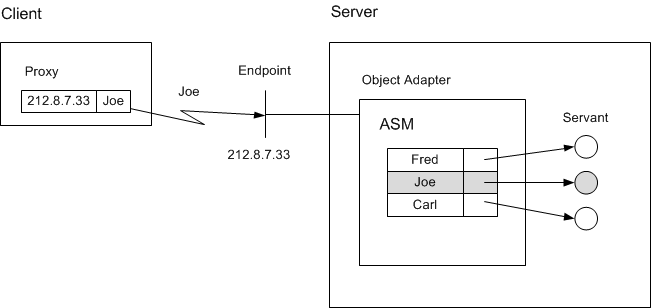The Active Servant Map
Each object adapter maintains a data structure known as the active servant map.
Role of the Active Servant Map
The active servant map (or ASM, for short) is a lookup table that maps object identities to servants: the key is an identity and facet, and the value is the associated servant.
In most servers, the ASM is the main component of the dispatch pipeline:

Dispatching a request to the correct servant.
Design Considerations for the Active Servant Map
Using an adapter's ASM to map Ice objects to servants has a number of design implications:
Each Ice object is represented by a different servant.
It is possible to register a single servant with multiple identities. However, there is little point in doing so because a default servant achieves the same thing.
All servants for all Ice objects are permanently in memory.
Using a separate servant for each Ice object in this fashion is common to many server implementations: the technique is simple to implement and provides a natural mapping from Ice objects to servants. Typically, on start-up, the server instantiates a separate servant for each Ice object, activates each servant, and then calls activate on the object adapter to start the flow of requests.
There is nothing wrong with the above design, provided that two criteria are met:
The server has sufficient memory available to keep a separate servant instantiated for each Ice object at all times.
The time required to initialize all the servants on start-up is acceptable.
For many servers, neither criterion presents a problem: provided that the number of servants is small enough and that the servants can be initialized quickly, this is a perfectly acceptable design. However, the design does not scale well: the memory requirements of the server grow linearly with the number of Ice objects so, if the number of objects gets too large (or if each servant stores too much state), the server runs out of memory.
Servant Activation and Deactivation
The term servant activation refers to making the presence of a servant for a particular Ice object known to the object adapter. Activating a servant adds an entry to the Active Servant Map (ASM). Another way of looking at servant activation is to think of it as creating a link between the identity and facet of an Ice object and the corresponding programming-language servant that handles requests for that Ice object. Once the object adapter’s dispatch pipeline has knowledge of this link, it can dispatch incoming requests to the correct servant. Without this link, that is, without a corresponding entry in the ASM, an incoming request for the identity results in an ObjectNotExistException. While a servant is activated, it is said to incarnate the corresponding Ice object.
The inverse operation is known as servant deactivation. Deactivating a servant removes an entry for a particular identity from the ASM. Thereafter, incoming requests for that identity are no longer dispatched to the servant and result in an ObjectNotExistException.
The object adapter offers a number of methods for managing servant activation and deactivation. We’ll focus on the most important ones:
python
add
Theaddmethod adds a servant with the given identity (and empty facet) to the ASM. Requests are dispatched to that servant as soon asaddis called. The return value is the proxy for the Ice object incarnated by that servant. The proxy embeds the identity passed toadd.You cannot call
addwith the same identity more than once: attempts to add an already existing identity to the ASM result in anAlreadyRegisteredException. (It does not make sense to add two servants with the same identity because that would make it ambiguous as to which servant should handle incoming requests for that identity.)Note that it is possible to activate the same servant multiple times with different identities. In that case, the same single servant incarnates multiple Ice objects.
addWithUUID
TheaddWithUUIDmethod behaves the same way as theaddmethod but does not require you to supply an identity for the servant. Instead,addWithUUIDgenerates a UUID as the identity for the corresponding Ice object. You can retrieve the generated identity by calling theice_getIdentitymethod on the returned proxy.addWithUUIDis useful to create identities for temporary objects, such as short-lived session objects. (You can also useaddWithUUIDfor persistent objects that do not have a natural identity, as we have done for the file system application.)remove
Theremovemethod breaks the association between an identity and its servant by removing the corresponding entry from the ASM; it returns a reference to the removed servant.
Once the servant is deactivated, new incoming requests for the removed identity cause the client to receive anObjectNotExistException. Requests that are executing inside the servant at the timeremoveis called are allowed to complete normally.
Deactivating an object adapter implicitly callsremoveon all its servants.
The Active Servant Map has “servant” in its name, and uses the term servant in parameter and method names. And indeed, the objects added to the ASM are often servants.
Nevertheless, the servant aspect is unimportant: the dispatch pipeline that uses the ASM only cares about dispatchers. Servants are just one particular kind of dispatchers, and you can actually add any kind of dispatcher to the ASM.
